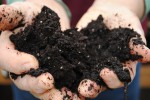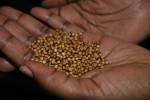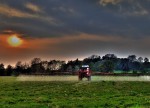News
2015-05-11 | permalink
Food supplies at risk as depletion of soil accelerates, scientists warn
 Soil fertility is decreasing (Photo: Eric Huybrechts/flickr)
Soil fertility is decreasing (Photo: Eric Huybrechts/flickr)
Soil erosion, combined with the effects of climate change and the loss of agricultural land to urban sprawl, will threaten global food security unless drastic action is taken to preserve the fertility of the world’s farmland, warns a paper published on May 7th in the journal Science. Soil provides the basis for agriculture, improves water quality and stores carbon. However, human activities are depleting Earth’s soil resources. According to the authors, unsustainable farming practices have accelerated the loss of soil through erosion and nutrient removal. Agriculture is therefore a major game-changer for the long-term health of soil - the “living epidermis” of the planet. Lead author Ronald Amundson, a professor at the University of California, Berkeley, said that “Ever since humans developed agriculture, we’ve been transforming the planet and throwing the soil’s nutrient cycle out of balance.” People are often not aware of the geological transformation because the changes happen slowly, he explained. Soil erosion has increased since the “green revolution” with its intensive use of chemicals and fertilisers. Although these methods helped to significantly increase crop yields, the ability of soil to support the growth of our food supply is now reaching a peak. The authors note that most of the Earth’s fertile soils are already in agricultural production. In addition, urbanisation is eating up productive farmland. Between 1970 and 2000, an area of agricultural land the size of Denmark became urbanised. Over the next 20 years, 1.5 million square kilometres of land, an area the size of Mongolia, will be converted to urban areas, the scientists warn. The supply of nitrogen, potassium and phosphorous, the three main fertilisers, could also become a major political challenge and lead to uncertainties. The nitrogen synthesis process is energy-intensive, making its supply dependent on fossil fuels. Phosphorous and potassium come from rocks and minerals which are not equitably distributed throughout the world. The authors point out that the United States has only 1 to 2% of global potassium reserves and its phosphorous reserves are expected to run out in about three decades. “Morocco will soon be the largest source of phosphorus in the world, followed by China,” Dr Amundson said. „These two countries will have a great deal of say in the distribution of those resources. Some people suggest we will see the emergence of a phosphorus cartel.” The authors call for a better management of soils. One proposal is to recycle nutrients captured in waste treatment facilities in the same way that paper and plastics are recycled from domestic waste, Dr Amundson said. “The nutrients lost can be captured, recycled and put back into the ground. Additionally, more efficient management is needed to reduce losses from soil. Excess nitrogen, for example, is considered a pollutant, with the runoff sapping oxygen from the nation’s waterways, suffocating aquatic life and creating dead zones in coastal margins. (ab)
2015-05-08 | permalink
WHO warns of looming obesity crisis in Europe
 Obesity is on the rise (Photo: Kyle May/flickr.com)
Obesity is on the rise (Photo: Kyle May/flickr.com)
Europe will face an obesity crisis of enormous proportions by 2030 unless immediate action is taken, according to latest projections released by the World Health Organisation (WHO) on Wednesday. At a congress in Prague, the WHO’s Regional Office for Europe presented the results of an obesity forecast which was undertaken with the UK Health Forum. The experts looked at data from all European countries and compared 2010 figures with projected levels for 2030. Being “overweight” is defined as having a Body Mass Index (BMI) between 25 and 30 and “obese” by a BMI of 30 and above.They present a worrying picture of rising obesity across Europe. Ireland leads the trend - 91% of men and 85% of women in the country are expected to be overweight by 2030. The overweight category also includes obese people. Almost 57% of Irish women are likely to be obese in 2030, compared with 23% in 2010. In the UK, 73% of men and 63% of women are forecast to be obese in 2030. One third (33%) of women will be obese in 2030, compared with over one quarter (26%) in 2010, while obesity figures for men will rise from 26% to 36% over the same period. Dr Laura Webber, of the UK Health Forum, warned there was “a worrying picture of rising obesity across Europe“. She said: “ Policies to reverse this trend are urgently needed. Although there is no ‘silver bullet’ for tackling the epidemic, governments must do more to restrict unhealthy food marketing and make healthy food more affordable.“ Other countries facing growing obesity problems include Greece, Spain, Austria and the Czech Republic. An estimated 77% of Greek men is forecast to be overweight by 2030 compared to 66% in 2010, while the proportion of obese Greek men will more than double from 20% to 44% over the same period. Obesity levels for Greek women are predicted to jump from 20% in 2010 to 40% in 2030. Even Sweden, where there has traditionally been a low prevalence of obesity, will see significant rises. Only the Netherlands seems to be doing slightly better than their neighbours. Only half of Dutch men will be overweight and just 8% obese by 2030. For Dutch women, the proportion of overweight will remain stable and the obesity rate is predicted to fall from 13% to 9% during this period. (ab)
2015-05-04 | permalink
Climate change threatens one in six species, new study
 Amphibians are at risk (Photo: Yamanaka Tamaki/flickr)
Amphibians are at risk (Photo: Yamanaka Tamaki/flickr)
New studies suggest one in six animal and plant species on the planet could face extinction if nothing is done to mitigate climate change. A study published Thursday, in the journal “Science” found that, extinction risks will accelerate with rising temperatures. Dr Mark Urban, an ecologist at the University of Connecticut, performed a meta-analysis of 131 published scientific studies on the risk of extinction from climate change. He found that extinction risks were highest in South America, Australia and New Zealand. These regions harbour many species that have adapted to live in habitats not found elsewhere. North America and Europe were characterised by the lowest risks. The majority of studies Dr Urban analysed were from Europe and North America, whereas only four studies focused on Asia. This means that poorly studied regions might face even higher risks but more research is needed for better insights. Endemic species with smaller ranges are predicted to face greater extinction risks, while risks do not vary significantly by taxonomic group. “Many species will be able to shift their ranges and keep up with climate change whereas others will not, either because their habitat has disappeared or because they can’t reach their habitat anymore,” Dr Urban explained. He evaluated how extinction risk varied depending on future global temperature increases, taxonomic groups, geographic regions, as well as on the different models and assumptions. Current predictions about extinction risks range from 0 to 54%. Overall, Urban found that 7.9% of species were predicted to become extinct from climate change. However, the rate of biodiversity loss is likely to accelerate with rising global temperatures. If future temperatures rise by 2 degrees compared with pre-industrial times, which most experts believe is no longer achievable, global extinction risk will rise from 2.8% at present to 5.2% in the future. With an increase of 3°C, 8.5% of species would become extinct. But under the scenario where global warming continues on its current path and temperatures rise by 4 degrees, 16% of species face extinction. “If the world does not come together and control greenhouse gas emissions and we allow the Earth to warm considerably we will face a potential loss of one in six species,” said Dr Urban. Commenting on the research, Prof John J Wiens of the University of Arizona, said the global extinction risk might be even higher than 16%, as the majority of studies analysed were from Europe and North America, where extinction risks are lower. (ab)
2015-04-28 | permalink
France gives doggy bag a chance in an effort to tackle food waste
 French households waste €400 worth of food every year (Photo: hupdiggs/flickr.com)
French households waste €400 worth of food every year (Photo: hupdiggs/flickr.com)
France is to adopt new measures with the goal of cutting food waste in half by 2025. In a report presented to the French government on April 14th 2015, Socialist MP Guillaume Garot put forward 36 proposals to prevent the mass disposal of food. His suggestions could soon be transposed into national law. The ideas include promoting ‘doggy bags’, which would allow restaurant-goers to bring their leftover meal home with them. According to the report, wasted food costs the average French household €400 a year, and the country up to €20 billion. The Ministry of Ecology, Sustainable Development and Energy estimates food waste to amount to 7.1 million tonnes. Mr Garot suggests prohibitions for supermarkets and retailers to throw away edible food, making it compulsory for supermarkets to donate unsold food to charitable associations. In addition, special “against waste” sections in supermarkets are to offer products which are nearing their expiration dates at a discounted rate. Another proposal is to replace the term “best before” and inform consumers about the various definitions of “expiry dates" in order to avoid misunderstandings. The report also includes the suggestion that restaurant owners should encourage customers to take leftovers home in so-called ‘doggy bags’ - until recently an unthinkable practice in French restaurants. Mr Garot admits that, “most customers don’t dare ask for the remains of their meal, and restaurateurs can see it as ‘degrading’ their dishes”. However, wastage has reached such levels that French diners need to overcome this “cultural obstacle” to prevent edible food from ending up in the bin, Garot adds. In an effort to make the doggy bags more palatable, hotel and restaurant industry union UMIH have signed a deal with one provider to “generalise the practice of the doggy bag in France”, calling them “le gourmet bag” instead. (ab)
2015-04-23 | permalink
U.S. award stirs up controversy over genetically modified Golden Rice
 Golden Rice compared to white rice (Photo: IRRI Photos/flickr)
Golden Rice compared to white rice (Photo: IRRI Photos/flickr)
Environmentalists and farmers’ organisations have heavily criticised the White House’s decision to award a humanitarian prize to the scientists who invented vitamin-enriched “Golden Rice”, describing it as a “hoax”. The United States Patent and Trademark Office (USPTO) announced Professor Ingo Potrykus of the Swiss Federal Institute of Technology in Zurich and Peter Beyer of the University of Freiburg in Germany as the winners of the “Patents for Humanity Award“. The scientists invented the genetically modified rice after a decade of research and granted Swiss agro-chemicals company Syngenta the rights to develop the technology. Golden Rice has been genetically modified to provide beta-carotene, a precursor of Vitamin A, one of the essential micro-nutrients. Vitamin A deficiency causes between 2 and 3 million deaths each year, as well as approximately 500,000 cases of blindness among children. The GM rice is being developed by the International Rice Research Institute (IRRI) in the Philippines. Preliminary results were mixed. In 2014, IRRI announced that more research would be needed before Golden Rice can be commercialised due to its very low yield performance compared to local varieties used by farmers. Biodiversity experts Vandana Shiva, laureate of the Right Livelihood Award, described the White House ‘award’ to Golden Rice as a desperate attempt to promote failed GMOs. Shiva commented: “Golden Rice is the Emperor who has no clothes. Since 1985 the promoters have been promising the miracle, but it is still far from introduction. In any case it is hundreds of percent less efficient than biodiversity alternatives in providing Vitamin A. Because the malnutrition crisis is so severe, we cannot waste time and resources on false promises.” Filipino farmer-scientist group MASIPAG believe that GM rice will not solve malnutrition: “Poverty and hunger are the main culprits in malnutrition cases. Therefore to address Vitamin A Deficiency, we should address the lack of resources to ensure that people have access to proper nutrition,” said Dr Chito Medina, National Coordinator at MASIPAG. The organisation has been pushing for agroecology and sustainable agriculture to improve food security in Asia. According to Medina, “Global and international studies such as the International Assessment of Agricultural Knowledge Science and Technology for Development (IAASTD) and the UN Special Rapporteur on the Right to Food have recognized agroecology and other farmer innovations as a means to address food security and rural development. Contextually appropriate technologies will better serve the farmers and consumers of developing countries, rather than a potentially harmful technology such as Golden Rice.” (ab)
- Scientists behind 'golden rice' GM crop to receive humanitarian award from the White House
- Right Livelihood Award: Laureates react to Award to Golden Rice researchers by the White House
- IRRI: What is the status of the Golden Rice project coordinated by IRRI?
- Masipag.org: Farmer-scientist group deplore secretive visit of Bill Gates to IRRI
- Seed Freedom: Tell the White House: No Award to Syngenta for Golden Rice Hoax
2015-04-21 | permalink
Fertile soils key to food security and sustainable development
 A handful of fertile soil (Photo: Pat Dumas/flickr.com)
A handful of fertile soil (Photo: Pat Dumas/flickr.com)
Healthy soils are the foundation of global food production and ought to become a top priority on the political agenda. This was one of the key messages of the opening pannel at the Global Soil Week, which started in Berlin on Monday. „If humanity’s overarching need for food security and nutrition, climate change mitigation and sustainable development is to be met, soil resources have to be given the global attention they deserve,” said Moujahed Achouri, Director of FAO’s Land and Water Division, in his opening address. However, the level of soil degradation is alarming in many countries. „Every year, 24 billion tonnes of fertile soil is lost: through erosion, development, flooding, mining - or through intensive agriculture,“ says Jes Weigelt of the Institute for Advanced Sustainability Studies (IASS) in Germany, which organises the conference together with partners such as FAO, UNEP or the European Commission. Global Soil Week brings together more than 550 land and soil management experts from 78 countries. Under the slogan „Soil. The Substance of Transformation“, this year’s meeting highlights the importance of land and soil in achieving the UN Sustainable Development Goals (SDGs). These goals, to be adopted by the UN General Assembly in autumn, will succeed the Millennium Development Goals and form the political foundation for sustainable development in both developing and industrialised nations. But a new IASS research paper released on Monday shows that the land demands made in the SDGs exceed the world’s existing land resources. Twelve of the proposed SDGs relate to the sustainable use of natural resources and several depend on the use of additional land resources, e.g. Goal 2 on food security and sustainable agriculture, as well as the goals on energy supply (Goal 7), production and consumption (Goal 12) and the sustainable use of ecosystems (Goal 15). IASS Executive Director Klaus Töpfer concluded: “The 17 SDGs are therefore not consistent. The demands for biomass and land that they make are far more than we can possibly meet. We need to set priorities, for example, where food security is concerned.” According to the publication, consumers play an important role as well. “The choices we make are of great importance: not only our decisions on what to consume, but also our decision to buy food in a way that it does not end up being wasted.” (ab)
2015-04-16 | permalink
Brazil’s Cancer Institute cautions against massive use of pesticides
 Pesticide application (Photo: Claus Isenberg/flickr.com)
Pesticide application (Photo: Claus Isenberg/flickr.com)
Brazil’s National Cancer Institute (INCA) has called for a substantial reduction in the use of pesticides, blaming the cultivation of genetically modified crops for the skyrocketing use of agrochemicals in the country. The institute, which is under the direct administration of the Ministry of Health, published a document last week, warning against the serious health effects of the massive pesticide use. The statement comes a few days after the World Health Organisation’s cancer research agency announced that glyphosate, the world’s most widely used weed killer, is likely to cause cancer in humans. Brazil is the biggest consumer of pesticides in the world; agrochemical sales reached $8.5 billion in 2011, up from $2 billion in 2001. National pesticide consumption is equivalent to 5.2 litres per person per year. The report describes the cultivation of genetically modified (GM) crops as the main reason for this sad record: “Importantly, the release of transgenic seeds in Brazil was one of the factors responsible for putting the country in first place in the ranking of agrochemical use since the cultivation of these modified seeds requires large quantities of these products.” The INCA points to the risks to human health from exposure to pesticides, particularly its relationship with certain types of cancer. Professor Luiz Felipe Ribeiro Pinto said, “we have to keep in mind that pesticide use sykrocketed over a period of just ten years. If we consider that cancer develops sometimes as long as 20 to 30 years after exposure, the consequences of this rapid increase in pesticide use will be felt in about 15 or 20 years time.” The report explains that acute pesticide poisoning is mainly affecting those directly exposed to chemicals as in the case of farm workers. Possible symptoms can be skin irritations, itching, vomiting, diarrhea or respiratory problems. However, chronic poisoning could also affect large parts of the population due to pesticide residues in food and the environment. Since the effects of chronic exposure such as: infertility, impotence, abortions or cancer, do not appear immediately, it is difficult to link them to the agent. The latest tests of Brazil’s health agency Anivsa revealed pesticide residues above the maximum permissible limit in many samples, as well as the presence of pesticides that are not allowed in the country. According to INCA's statement, the main focus must be on combating the use of pesticides, which contaminate all vital resources, including food, soil, water, breastmilk and air. The INCA therefore calls for a stronger regulation of pesticides and the promotion of agroecological alternatives to the dominant agricultural model with its dangerous dependence on GMOs and pesticides. (ab)
2015-04-13 | permalink
Report says a sustainable local food revolution is taking over Europe
 Farmers’ market in Prague (Photo: Tomas Kohl/flickr.com)
Farmers’ market in Prague (Photo: Tomas Kohl/flickr.com)
European citizens and small-scale sustainable farms are taking back control of the food system from large industrial businesses; this is the key message of a report released on Monday by Friends of the Earth Europe. According to the authors, the globalisation of food production has led to a monopoly within the agricultural sector, with just a few companies dominating the supply of seeds, pesticides, processing, logistics and food production. In 2011, four retailers controlled 85% of the German food market and three retailers controlled 90% of the food market in Portugal. Many people do not know what they are actually eating: supply chains are long and complex, leaving consumers with no idea about the origins of their food. However, more and more people are beginning to understand the benefits of responsible eating habits. There is a growing trend across Europe of farmers’ markets, on-farm shops or community supported agriculture (CSA) projects, which are creating new alliances between producers and consumers. These different initiatives are expressions of a growing grassroots movement that promotes local food chains, supplying sustainably-farmed, small-scale food – also known as 'agroecological' farming. The report features five case studies which illustrate different ways in which communities are supporting sustainable producers or re-invigorating local economies. In Italy, the Gruppi di Acquisito Solidale movement consists of groups of consumers who purchase collectively and directly from local producers. Over the past ten years, the number of GAS schemes has grown rapidly and it is estimated that there are now 2,000 groups in Italy, with a total annual turnover of €90 million. In northern Spain, three small-scale chicken farmers set up a chicken cooperative, Avicultura Campesina, with their own slaughterhouse, so that they can guarantee the whole production process from farm to table without any intermediaries. Another example are farmers’ markets in the Czech Republic: Since 2009, when the first farmers’ market was held in the Czech capital, the demand for fresh locally-grown produce has continued to increase. Within two years, there were more than 13 farmers’ markets in Prague. According to Jana Spilkovà, an Assistant Professor at Prague’s Charles University, “They illustrate the start of a noticeably new consumer and producer culture, created as concerns about food consumption, ethics, social diversity, and urban renewal come together.” Friends of the Earth Europe calls on policymakers to recognise the benefits of short food supply chains for people and the environment and to support them in multiple policy areas including health, environment, rural development, trade and agriculture. The report concludes: "Locally-produced and affordable agroecological food should be the backbone of a food system that increases our food sovereignty. The ‘business-as-usual’ model can no longer be considered an option for a well-functioning food system in the future.“ (ab)
2015-04-09 | permalink
Seeds under attack: Farmers stand up for seed sovereignty
 Saving seeds (Photo: Global Crop Diversity Trust/flickr)
Saving seeds (Photo: Global Crop Diversity Trust/flickr)
Seed saving, a thousand-year-old practice which forms the basis of farming is fast becoming criminalised. A new report released by GRAIN and La Via Campesina on Wednesday shows how agribusiness and governments are moving to stop farmers from saving and exchanging their seeds and how farmers are fighting new seed laws. According to the booklet, free trade agreements, bilateral investment treaties and regional integration initiatives are hardening ‘soft’ forms of ownership rights over seeds. Under corporate pressure, seed laws and plant variety rights in many countries are being revised to adapt to the new demands of the seed and biotechnology industry, limiting what farmers can do with their seeds and the seeds they buy. These laws are being reinforced by other regulations that are supposed to ensure seed quality, such as regulations related to the health of plants or seed certification. Guy Kastler commented for La Via Campesina that, “control over seeds must remain in peasants' hands”. Over centuries, peasant farmers have created the thousands of varieties of crops that are the basis of the world's food supply and diversified diets. Peasant seeds guarantee the food sovereignty of rural communities and urban populations. GRAIN and La Via Campesina therefore stress the need to replace these new laws with regulations that guarantee the rights of peasants to conserve, use, exchange, use and sell their seeds and protect them from biopiracy. The publication also shows how social movements worldwide, especially peasant farmers organisations, have resisted and successfully mobilised to prevent such laws from being passed. In 2014, after four years of mobilisation, Chilean farmers organisations and social movements won an important victory against an attempt to privatise peasant seeds. In Ghana, students and trade unions have joined small-scale farmers organisations in mobilising against a Plant Breeders’ Rights (PVP) Bill, popularly hailed as the ‘Monsanto Law’. GRAIN and La Via Campesina hope their document will help strengthen resistance worldwide. They say that it is important to block the legislative process, because once the laws are passed, resistance becomes harder and more complex. However, according to the report, “the best way to defend seeds – and to defend the practices of using and sharing that keep seeds alive – is to continue to grow them, look after them, and exchange them, in every locality. Keeping farming systems alive is the best way to keep seeds alive.” (ab)
2015-04-02 | permalink
U.S. to place restrictions on glyphosate use
 Herbicide application (Photo: Will Fuller/flickr.com)
Herbicide application (Photo: Will Fuller/flickr.com)
U.S. regulators will put new restrictions on glyphosate, the world’s most widely used herbicide, in an effort to address the rapid expansion of weeds resistant to the chemical. According to Reuters, the Environmental Protection Agency (EPA) confirmed it will require a weed resistance management plan for glyphosate, the key ingredient in Monsanto’s Roundup weed-killer. The EPA has not yet given details but Reuters reports that the measures will include weed monitoring, farmer education and remediation plans. The requirements could be similar to those placed on a new herbicide product developed by Dow Chemical. The company must report to the EPA about cases of weed resistance and inform farmers and other stakeholders about the difficulties of controlling them. The area of U.S. cropland infested with glyphosate-resistant weeds has expanded to 61.2 million acres (24.7 million hectares) in 2012, up from 40.7 million acres in 2011. Not only are glyphosate-resistant weeds expanding geographically; the rate at which they are spreading is gaining momentum, increasing 25% in 2011 and 51% in 2012. These so-called superweeds, such as horseweed and Palmer amaranth, hinder crop production and lead to an increase in herbicide use. According to the U.S. Department of Agriculture (USDA), at least 283.5 million pounds (128,000 tonnes) of glyphosate were used in U.S. agriculture in 2012, up from 110 million pounds (49,000 tonnes) in 2002. USDA says that more than 90% of the soybeans and cotton grown in the United States last year, and 89% of the maize, was genetically modified to withstand herbicide use. The EPA’s announcement comes in the wake of a finding by the World Health Organization’s cancer research unit earlier this month that glyphosate is “probably carcinogenic to humans”, a conclusion based on a review of years of scientific evidence. However, the EPA’s restrictions only focus on the herbicide’s contribution to weed resistance and are not intended to address public health concerns. Last week, several leading non-governmental organisations urged the Obama administration to “weigh heavily” the WHO conclusion. In a letter to the EPA, the organisations called the WHO announcement “extremely timely, as EPA is preparing to issue its preliminary risk assessment of the widely used herbicide“. For the required reevaluation of the herbicide health data will also be taken into account. (ab)

